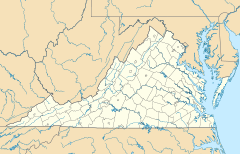- Mosby Tavern
-
Mosby Tavern
 Exterior of Mosby Tavern.
Exterior of Mosby Tavern.Coordinates: 37°33′56.78″N 78°2′9.74″W / 37.5657722°N 78.0360389°WCoordinates: 37°33′56.78″N 78°2′9.74″W / 37.5657722°N 78.0360389°W Area: 223 acres (0.90 km2) Built: 1740 Architectural style: Federal NRHP Reference#: 03000214 Added to NRHP: April 11, 2003 Mosby Tavern, also called Old Cumberland Courthouse or Littleberry Mosby House, is a National Register of Historic Places building in Powhatan County, Virginia. Located southeast of the intersection of U.S. Route 60 and State Route 629 in Powhatan County, Virginia, with a street address of 2625 Old Tavern Road, it began as a small one-room house built by Benjamin Mosby in 1740, and remains a private residence today.[1]
Mosby Tavern was listed in the National Register of Historic Places on April 11, 2003, and a monument was dedicated at the site on June 15, 2008.
Contents
History
Originally located in Goochland County, Mosby Tavern was in the western part of the county which became Cumberland County in 1749. From the county formation until the formation of Powhatan County in 1777, Mosby Tavern served as the Cumberland County courthouse and jail,[2] as well as being a tavern and the private residence of the Mosby family.[3] This, plus a popular racetrack across the road, made Mosby Tavern the center of the community.[4] During the American Revolution the tavern also served as a rendezvous for the county militia.
For at least 100 years from its construction, Mosby Tavern was used as a private residence by the Mosby family, owned by: Benjamin Mosby, who purchased the land and constructed the original building in 1740; Colonel Littleberry Mosby Sr (also spelled "Littlebury") (17??-1809?); General Littleberry Mosby Jr (1757–1821), who was the third child, but the oldest living son at the time of his father's death, and who was so disappointed that many family members left the area that he made Littleberry III's inheritance conditional on the condition his return to Virginia; Edward Mosby, Littleberry Jr's younger brother, to whom Mosby Tavern passed when Littleberry III died in Tennessee without returning.
The tavern was also used as the Powhatan County courthouse and jail [5] until 1779, when the county seat was moved to a newly constructed courthouse in Scottville.[6] After 1779 Mosby Tavern generally ceased to be used for public meetings, although the stature of the Mosby family in the area meant that even without official standing their home continued to play a major role in the social life of the area.
Architecture
Mosby Tavern began as a small one-room house built by Benjamin Mosby in 1740.[7] By the time Benjamin's grandson, Littleberry Mosby Jr, owned it in the early nineteenth century it was a one-story, hall-parlor plan frame dwelling shown on early nineteenth century insurance policies as 34' by 28'.[8] According to tax records, the property value increased substantially in 1849 and 1859, and it is likely that most of the major additions were made during that time, expanding the house to a center hall-plan, two-story frame building with single-story wings. A two-story rear addition was constructed around 1950, and a rear porch was added in 1988, bringing the house to its present form.[9]
Notes
- ^ NRHP listing.
- ^ NRHP listing. "Benjamin “agreed to build a courthouse, prison, pillory, and stocks…at his own expense for the use of this county…and provide…convenience for holding courts at this place.”"
- ^ NRHP listing. "The tavern hosted nearly thirty years of court meetings for the Cumberland and later Powhatan courts...Cumberland court proceedings met at the Mosby residence until 1777 when it fell within the bounds of the new Powhatan County."
- ^ Ramage, p 13
- ^ NRHP listing. "Mosby Tavern is significant under Criterion A for it served Cumberland and later Powhatan Counties as a courthouse and prison while it was also an ordinary and private residence."
- ^ NRHP listing. "The Powhatan court convened at Mosby Tavern for two years before it moved to a courthouse in Scottsville."
- ^ NRHP listing. "It has evolved from a small single-pile, one-room house built about 1740."
- ^ NRHP listing. "Originally a one-story, single-pile, hall-parlor plan frame dwelling shown on early nineteenth century insurance policies as 34' by 28', Mosby Tavern is now a center hall-plan, two-story frame dwelling with nineteenth-century one-story wings."
- ^ NRHP listing. "The Hatcher family added the two-story rear addition around 1950 and the present owners extended the east side of the addition and added the rear porch shortly after they purchased the property in 1988."
References
- Ramage, James A. (1999). Gray Ghost: The Life of Col. John Singleton Mosby. University Press of Kentucky. ISBN 0813121353.
- National Register of Historic Places, Mosby Tavern listing dated April 11, 2003.
- "National Register of Historic Places: Virginia - Powhatan County". http://www.nationalregisterofhistoricplaces.com/va/Powhatan/state.html. Retrieved 2009-02-24.
- "National Register of Historic Places Registration Form for Mosby Tavern". http://www.dhr.virginia.gov/registers/Counties/Powhatan/072-0054_Mosby_Tavern_2003_Final_Nomination.pdf. Retrieved 2009-03-01.
Categories:- 1740 architecture
- Buildings and structures in Powhatan County, Virginia
- Hall and parlor houses
- County courthouses in Virginia
- Federal architecture in Virginia
- Taverns in Virginia
- Courthouses on the National Register of Historic Places in Virginia
- Jails on the National Register of Historic Places
Wikimedia Foundation. 2010.

